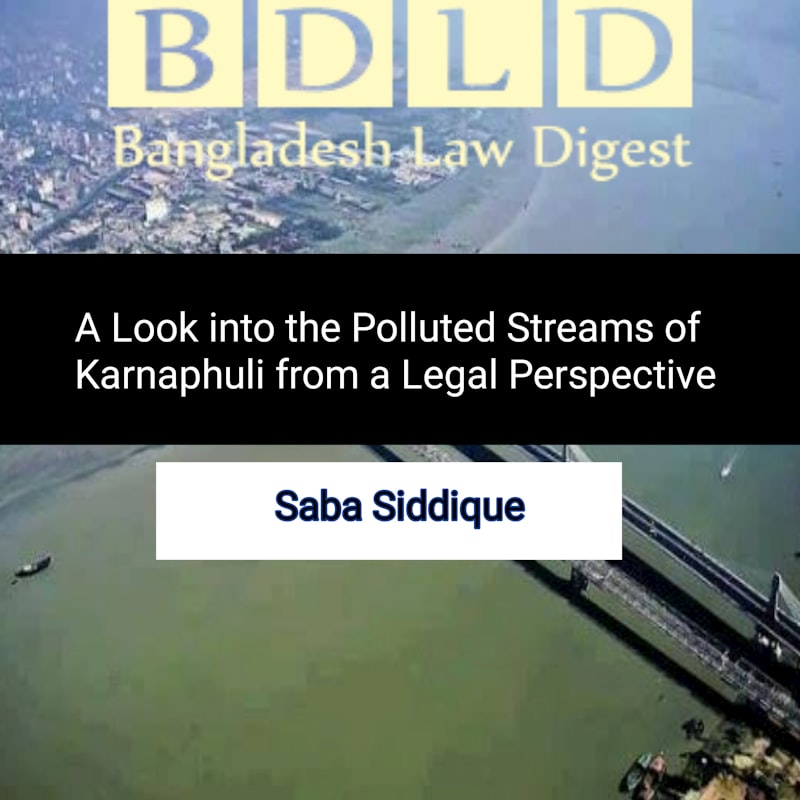The Bangladesh Environment Conservation Act 1995 was enacted for fulfilling three major objectives namely: conservation of environment, improvement of environmental standards and the control and mitigation of environmental pollution. The Act was formulated on the basis of the policy framework provided by the Environment Policy of 1992 and the National Environment Management Action Plan (NEMAP) of 1995.
The BECA also defines certain environmental offences and prescribes for their punishments. Moreover, to supplement and fulfill the objectives of the Act, the Bangladesh Environment Conservation Rules (BECR), 1997 was adopted in accordance with section 20 of the BECA, 1995.
However, the Bangladesh Environment Conservation Act, 1995 and Rules, 1997 are not free from a number of loopholes or shortcomings. There is a maxim that ‘prevention is better than cure’, but the BECA of 1995 by the terms ‘improvement of environmental standards’ and ‘mitigation of environmental pollution’ in its preamble indicates that it is cure-oriented and it only copes with the curative measures rather than the preventive measures. The BECA, 1995,in true sense, deals with the post-harm situations.
The Act does not entail any obligation on the state to conserve the environment despite the fact that the extended meaning of the term ‘right to life’ includes the ‘right to safe and healthy environment’. It is notable here that in the latest Bangladeshi statute Wildlife (Conservation and Safety) Act, 2012, there is a clear statement as to state’s obligation under Article 18A of the Constitution about conservation and safety of wildlife of Bangladesh. However, the Articles 31 and 32 of the Constitution safeguard ‘right to life’ as the fundamental right. The High Court Division (HCD) in the legendary case Dr. Mohiuddin Farooque vs Bangladesh and others (48 DLR, p. 438) declared that “right to life” includes right to fresh air and water and a situation beyond animal existence in which one can expect normal longevity of life. Though the ‘right to safe environment’ is proved to be a fundamental right by the legal and judicial activism of the higher judiciary of our country, the BECA is altogether silent about the state’s obligation to conserve the environment.
In section 3, the term ‘Government’ is a vague one. It creates the question in our minds – who is the Government under the BECA, 1995? There is no reference to any specific criteria for determining the ‘Government’ who would set up the Department of Environment (DoE) headed by the Director General (DG).
Section 3(2) of the BECA, 1995 speaks about the appointment of the Director General (DG) in the Department of Environment, but it does not state any definite qualifications upon which the DG will be appointed. The appointment process is totally dependent upon the satisfaction of the Government.
Section 4 of the Act gives unfettered and unlimited powers to the Director General (DG) of the Department of Environment (DoE). The wording ‘may’ in section 4 denotes that the DG is not bound to take necessary measures in order to conserve the environment and the DG can do anything at his sweet will. It is noteworthy that under section 4 the DG is empowered to take immediate action against any industry and to close the industry without giving any “prior notice” to the industry, if he ‘considers’ that the industry is likely to endanger public life. Taking any action against any person or any industry or corporation without giving any prior notice absolutely goes against the principles of natural justice. Also, such a closure of the industries is totally dependent on the DG’s satisfaction. This most often creates rooms for DG to resort to corruption.
Section 5 of the Act requires the Government to declare the ‘ecologically critical areas‘. It is palpable that the environment experts can play a vital role in declaring the ecologically critical areas. Section 5 has no reference to the matter.
According to section 6B, the hill or hillock may be cut for ‘inevitable national interest’. The term ‘inevitable national interest’ is a vague one. There are no specific objective criteria to determine ‘inevitable national interest’. In the prominent case Dr. Mohiuddin Farooque vs Bangladesh [49 DLR (AD) 1997, p.1] the question of national interest was a central issue. In that famous case, the legality of an experimental structural project of the ‘Flood Action Plan (FAP 20)’ at Tangail, Bangladesh was questioned on this very point of national interest. For so called inevitable national interest, restrictions on the wetlands may be relaxed under the section 6E of the BECA, 1995.
Though the section 6C speaks about production, import, stock, transportation of hazardous waste, it does not speak about reuse, recycling and reduction of waste.
Section 12 of the Act speaks about ‘Environment Clearance Certificate’. It is yet unclear what will happen if the Department of Environment (DoE) is unable to meet the timetable to grant the Environment Clearance Certificate (ECC). Section 12 is silent about the standards and parameters upon which the ECC should be obtained. Section 12 also speaks about the formulation of Environment Impact Assessment (EIA) report, but it does not prescribe the role of environment experts in preparing the EIA report. However, it provides for EIA report only of the industrial projects not of the non-industrial projects. As per Rule 7 of the Bangladesh Environment Conservation Rules (BECR), 1997, the industries belonging to highly polluting Red categories must obtain ‘No Objection Certificate (NOC’ of the local government authority. But the Conservation Act or Rules does not provide any procedures to be followed by the local government authority in issuing such a ‘No Objection Certificate (NOC)’. However, India and some other countries prescribe ‘public hearing’ which means that before establishing any industry, the people of the locality will be convened by the concerned government local authority in order to know whether they have any objection to the erection of the industry and what are the harms and risks which they think, will occur to the environment. On the other hand, Principle 10 of the Reo Declaration, 1992 provides for the participation of all concerned citizens in environmental issues as well as an opportunity for all concerned citizens to participate in decision making processes. Unfortunately, any single provision concerning such a public hearing and public participation have not yet been incorporated in BECA, 1995 and BECR, 1997.
Section 14 of the Act ousts the court’s jurisdiction in terms of entertaining appeal from an order or direction issued under the Act. Only the Appellate Authority constituted by the Government has the jurisdiction to entertain appeal under the Act. The decision of such Appellate Authority shall be final. No review and revision against the orders of such an Appellate Authority will be allowed.
The Act under section 15 prescribes no strict penalty measure against the multi-national companies. The natural persons and the juristic persons are treated alike under this Act. Section 15 of the Environment Conservation Act, 1995 substantiates that the court can impose the maximum penalty of 10 lac taka both for natural and juristic persons irrespective of the gravity of offence or torts. It is worth citing here that the National Green Tribunal Act (NGTA), 2010 of India provides for maximum penalty of 10 crore and 25 crore rupees for a natural person and legal person respectively.
The insertion of the ‘Good Faith Clause’ in section 18 is an inevitable stumble. The DG can do anything he wishes under the veneer of good faith.
In compliance with section 20 of the BECA, 1995, the Government has made rules under the Environment Conservation Rules, 1997 for the purpose of determining the standards of air, water, sound, soil and other components of the environment. Regarding management of toxic and hazardous substances, the Rules have broadly defined guidelines for disposal of waste from different categories of industries. But unlike the Environment Protection Rules (EPR) of India, the ECR, 1997 have not specified the permissible extent of emissions or the obligations of corrective actions.
The parallel environmental conservation rulings of many countries such as the Environment Conservation Act, 1989 of South Africa reaffirm the spirit of the international conventions, treaties, agreement etc. relating to the environment which have been ratified by them. But the BECA, 1995 makes no reference to the international instruments relating to environment to which Bangladesh is a party.
The Canadian Environment Protection Act (CEPA), 1999 lays emphasis on the ‘public participation’ in environment conservation regime. The CEPA, 1999 also puts stress on conducting research and studies relating to pollution prevention, nature, effects, control of pollution. Besides, it provides for publishing information respecting pollution prevention and a periodic report on the state of Canadian environment. The CEPA under sections 166 and 175 speaks about the determination of “international air pollution” and of “international water pollution” respectively. But the BECA, 1995 does not refer to these important aspects.
Genetically Modified Organism (GMO) is an important environmental issue. The term “Genetically modified organisms (GMOs)” can be defined as the organisms (i.e. plants, animals or microorganisms) whose genetic characteristics have been altered by the insertion of a modified gene or a gene from another organism using the techniques of genetic engineering. The environment conservation regimes of many countries include the provisions relating to GMO. The Environment Protection Act, 1990 of the UK under section 106 and the Environmental Management Act, 2004 of Netherlands under section 2.25 speak about “Genetically Modified Organism (GMO)”. But the BECA, 1995 is unfortunately silent about GMO.
Public awareness is a must to protect the environment. Principle 10 of the Reo Declaration, 1992 provides for public awareness regarding environmental issues. The Environmental Management Act, 2004 of Netherlands under section 4.7 provides for drawing up an ‘annual national environmental program’ in order to raise public awareness in terms of environment conservation. The BECA, 1995 makes no reference to such an exigent aspect.
The Environment Protection Act (EPA), 1990 of the UK depicts both the hazardous and non-hazardous waste. The EPA, 1990 also portrays the powers and functions of the waste disposal authorities and of the waste collection authorities. The BECA, 1995 only speaks about the hazardous waste. It does not refer to the municipal waste which is not deemed to be hazardous. Municipal waste generally includes that waste generated by households, shops, offices and also includes paper, glass, plastic, metals. It is completely silent about the waste disposal authorities and the waste collection authorities let alone their powers and functions.
Noise is a major environmental factor. Noise emitted from vehicles, machineries on highways, roads, footways etc. may grimly affect the environment. Several countries included this environmental factor within the ambit of their environmental legislations. Section 79 of the Environment Protection Act (EPA), 1990 of the UK and sections 326 and 327 of the Resource Management Act, 1991 of New Zealand can be mentioned here as the appropriate examples. But this important point remained out of touch in the BECA, 1995.
In this age of digitalization, radiation from mobile phones or towers may cause a bigger health hazard for citizens. Both the BECA, 1995 and the BECR, 1997 do not speak about this important point.
Sight pollution is a common problem in Bangladesh. Sight pollution means any unwanted sight that mentally or physically affects the community or creates any health hazard. For example, at midday, you are riding a motorcycle to your home hungry for your lunch. While approaching your home, you see an ugly scene of huge mountains of waste on the roadside, including wasted food, used banana leaves, putrifying fruits, etc.After seeing that, can you enjoy your lunch at home? Also, Excessive advertisements, singnboards or billboards etc. in the public places are the common forms of sight pollution. In our modern life, especially in cities, the hazards of sight pollution are many. The BECA, 1995 does not point out such an environmental phenomenon.
In our modern life, light pollution has now become a dangerous problem. The inappropriate or excessive use of artificial light – known as light pollution – can have serious environmental consequences for humans, wildlife, and our climate. The BECA, 1995 does not deal with such an environmental factor .
The BECA, 1995 and the BECR, 1997 are not exhaustive and the both are incompatible with the demands of time. They should be amended as per the demands of time. The BECA, 1995 should encompass all the environmental issues which are still out of the touch. All the ambiguities and lacunas in the both should be removed. People’s participation in environmental decision making must be ensured and protected by law.
━━┅━━━┅━━
Copyright: Any unauthorized use or reproduction of Bangladesh Law Digest (BDLD) content for commercial purposes is strictly prohibited and constitutes copyright infringement liable to legal action.
Relevant Article : A Critical Evaluation of Bangladesh Environment Conservation Act 1995














